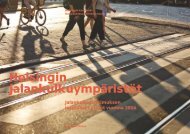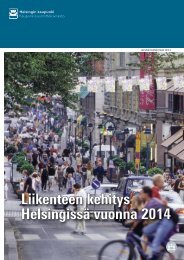Helsinki City Plan
esite-2017-1-en
esite-2017-1-en
You also want an ePaper? Increase the reach of your titles
YUMPU automatically turns print PDFs into web optimized ePapers that Google loves.
<strong>Helsinki</strong> is growing<br />
sustainably<br />
The new <strong>Helsinki</strong> <strong>City</strong> <strong>Plan</strong><br />
sets the direction for the<br />
city’s growth over the next<br />
30 or so years. The <strong>Plan</strong><br />
makes it possible to have<br />
approximately 860,000 inhabitants<br />
and 560,000 jobs in<br />
<strong>Helsinki</strong> in 2050. <strong>Helsinki</strong> will<br />
become a denser city than it<br />
is today, with several district<br />
centres connected by public<br />
transport. The city centre will<br />
expand northwards, alongside<br />
motorway-like areas transformed<br />
into city boulevards.<br />
Of the new construction activities, roughly one<br />
third is located in the central city expanding<br />
alongside the city boulevards, one third is<br />
implemented as as infill development in the<br />
new regeneration areas of older estates and<br />
one third in new construction areas, such as<br />
the decommissioned Malmi airfield and in rail<br />
traffic hubs.<br />
Sustainable modes of transport are part<br />
of the <strong>Helsinki</strong> of the future. The aim is to<br />
ensure that every part of the city can be easily<br />
reached by public transport. Walking and<br />
cycling will be given top priority among the<br />
different modes of transport. The urban structure<br />
must be such that everyday services can<br />
be obtained nearby. A dense urban structure<br />
and sustainable transport play a key role in<br />
<strong>Helsinki</strong>’s pursuit of significant reductions in<br />
carbon dioxide emissions. <strong>Helsinki</strong>’s goal is to<br />
be a carbon neutral city by 2050.<br />
Good urban life requires adequate recreational<br />
areas and the opportunity to enjoy<br />
nature. The <strong>Helsinki</strong> of the future will continue<br />
to be a green city whose strengths include<br />
extensive unfragmented green areas, city<br />
forests and valuable cultural environments.<br />
The city’s residents need parks, squares and<br />
marketplaces that serve as meeting places and<br />
event locations. The sea is a strong element<br />
of <strong>Helsinki</strong>’s cityscape, and the city has a long<br />
coastline. This is something we can all continue<br />
to enjoy in the future.<br />
There is high demand for urban housing.<br />
The <strong>City</strong> <strong>Plan</strong> provides the opportunity to<br />
increase the urban housing supply by expanding<br />
the city centre to benefit those who<br />
value urban living. At the same time, the <strong>Plan</strong><br />
ensures that the <strong>Helsinki</strong> of the future will also<br />
include green and natural living environments<br />
for those who value living close to nature.<br />
Mikko Aho<br />
Executive Director,<br />
Urban Environment,<br />
<strong>City</strong> of <strong>Helsinki</strong><br />
<strong>Helsinki</strong> <strong>City</strong> <strong>Plan</strong> 5






